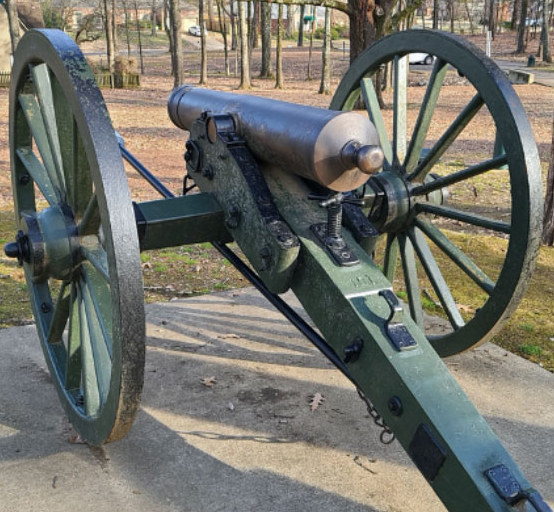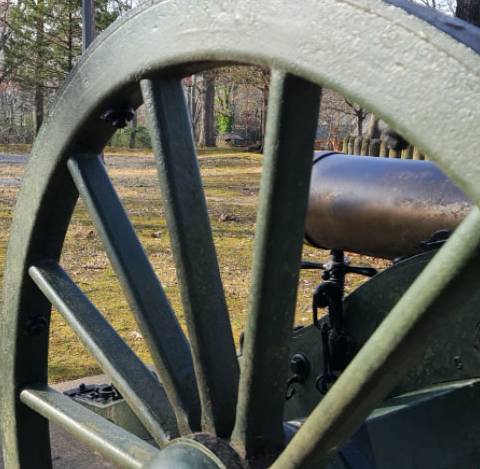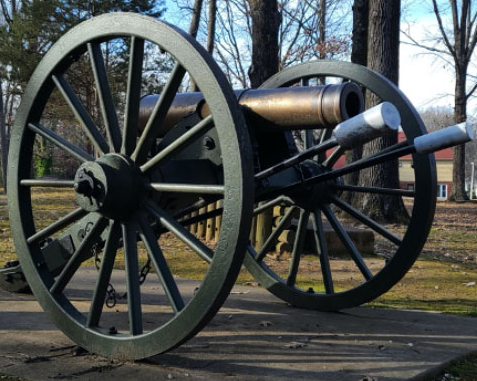
Fort Germantown
By Andy Pouncey
April 13, 2006
The Germantown Redoubt or Fort Germantown Park is a well-preserved example of the very fragile, small-unit field and garrison post widely used during the Civil War. Its importance lies in the fact that little information, from an archaeological context, is available regarding smaller fortifications relatively early in the war. The redoubt has provided data on earthwork construction, and local garrison armament, and daily life, in addition to Union supply effectiveness to a relatively minor outpost. Such research provides a rare opportunity to study virtually intact structural and daily living deposits at a garrison outpost. This gives us a balanced understanding of military occupation life well behind the front lines.
At the outset of the war, the Memphis and Charleston Railroad and its connections across northern Alabama to Chattanooga, Knoxville, Lynchburg, and Richmond represented the only effective rail connection in the Confederacy between the Mississippi River and the east coast. This was thus a vital Confederate supply route across the nation as well as a means of shifting troops in response to threats at various points.
The capture of both Corinth and Memphis by Federal forces in May and June of 1862 effectively ended the strategic utility of the railroad for the Confederates. The Federal troops, now in control of the Memphis and Charleston Railroad, used the tracks as an important part of the transportation for Grant’s siege of Vicksburg in the spring of 1863.
The first measure of follow-up, by the Federal army to its winter and spring victories, was the occupation of western Tennessee during June and July of 1862. Germantown was sacked and burned on July 23, 1862.
The Union Army was dispersed into a large number of small, scattered garrisons with severe supply and coordination problems in the face of escalating Confederate guerrilla warfare. Regiments from the 16th and 17th Armies were deployed in January 1863 to secure the Memphis-Charleston railroad line and protect it from these guerrillas.
In an effort to keep the railroad line running and communications open between Memphis and Moscow, 39 miles to the east, Major General James B. McPherson ordered on January 13, 1863, “at all the points to be guarded, defensive stockades must be constructed to render the command safe against a sudden cavalry dash” (e.g. Germantown Redoubt). General Ulysses S. Grant followed with Special Orders No. 15 on January 15, 1963, stating in part that, “it is regarded of primary importance the line east from Memphis to Corinth should be maintained”.
Fearing rebel attacks, the Union established picket lines in Germantown. No attack by Confederate forces was ever attempted here.
By the end of October 1863, Confederate scouting reports indicated that all Federal infantry were gone from the Memphis and Charleston Railroad and a series of cavalry raids were launched against it. The removal of most infantry units from railroad guard duty during the fall of 1863 was followed quickly by attempted destruction of the redoubt. All headquarters were moved to Memphis, along with at least a major portion of the troops, by June 1864.
Fort Germantown, a 4.95-acre site, may be found by going south on Honey Tree Drive (third street east of Hacks Cross Road) off Poplar Pike, across from Hugh Frank Smith’s Horse and Pony Farm. Go south on Honey Tree Drive to the railroad tracks. Wait for the first train to go by and you will better understand the position of this Civil War redoubt.
Redoubt
By Andrew Pouncey
The merging of historical and archaeological data for the “redoubt” at Fort Germantown gives a glimpse of this location as an important resource significant in Tennessee’s participation in the Civil War. Built in the early spring of 1863, the Germantown redoubt is a well-preserved earthen fortification built along the Memphis-Charleston Railroad.
Archaeological investigations at the fort to date reveal an earthwork with inner face support of posts and unidentified horizontal elements and a shallow outer ditch from which the earthen wall fill was obtained. The removal of most infantry units from railroad guard duty during the fall of 1863 may well have been followed quickly by attempted destruction of the redoubt. Even after its burning, the redoubt would have provided significant shelter to troops inside if attacked, but there is no further record of a long-term infantry garrison at Germantown and no archaeological evidence of repairs to the redoubt after it was burned.
The redoubt was found to form a square approximately 110 feet on each side, with bastions on the northeast and southwest corner. Surviving relief of the walls ranges from one to two feet, with four to five feet of thickness at the base. The exterior ditch averaged about a foot in depth and ranged from five to ten feet in width as presently observable on the surface. The bastions are partly closed across the gorge and an apparent entrance is on the east side. Open woods covered the site with visibility of contours both winter and early summer due to the lack of undergrowth.
Design of the redoubt may well have followed generally recognized convention, but the particulars remain obscure. Earthwork thicknesses on the order of 12-16 feet were required to resist the first of the smaller artillery in general field use, but only about 15 inches to resist musket fire. Photographs of field and semipermanent fortifications indicate at the time, extensive use of sandbags and gabions in the sandy eastern soils, and various combinations of posts, logs, poles, and boards with earthen facings in the area west of the Appalachians.
At this redoubt, posts were more closely spaced, and the embankments were thinner. No evidence of boards or logs were found, but the posts were too far apart to provide any semblance of support for a loose earthen embankment. Saplings woven between the posts thus seem the most likely filler between posts.
Artifacts were scarce in the areas excavated, but at least the distribution and nature of some classes provide useful information. Of particular interest is the distribution of Minie balls; only .69 caliber specimens came from original construction contexts, such as the curtain wall post trench. This distribution implies that the original builders of the redoubt, presumably the 49th Illinois Infantry Regiment were armed with rifled U.S. Model 1842 muskets or perhaps imported French or Belgian rifle-muskets, while the later occupants presumable the 52nd Illinois Infantry, would have been armed with a more recent vintage of rifle-musket using .58 caliber ammunition. The .58 caliber rifle-muskets in common use at the time included the U.S. Model 1855, U.S. Model 1861, U.S. Model 1863, and British Enfield.
Dr. Gerald Smith and his team from the Anthropology Department at the University of Memphis were responsible for the archaeological research and National Register nomination for Fort Germantown.
Source:
National Register of Historic Places Nomination for Fort Germantown, Germantown, TN by University of Memphis Anthropology Department, Dr. Gerald Smith.
The Cannons of Fort Germantown
The cannons at Fort Germantown are reproductions of the 12-pound Field Howitzers that were stationed here in this redoubt by Federal forces in 1863 during the War Between the States.
While considered an effective and serviceable cannon before the American Civil War, the Howitzer, firing a 12-pound cannonball, was a poor weapon in comparison to the new, longer-range, 12-pounder “Napoleon” Light Field Gun and three-inch rifles. Except in the west, such as Tennessee, where light and more maneuverable weapons were required, most Howitzers in Federal service were melted down and replaced with Napoleons.
The Confederate Army, with a shortage of usable cannons, maintained the Howitzer in their arsenal for most of the war.
The 12-pounder Howitzer was by far the most effective field piece of the time for use at any range less than 400 yards. Its large shells gave it firepower, while its lightweight, at less than 800 lbs., made it highly mobile, easy to position, and particularly useful in defending small areas such as this fortification. The rolling hills of most of Tennessee and the somewhat forested land were better suited to the gun’s short-range.
At Fort Germantown, a section of the Howitzers (two) was assigned to supplement the U.S. Infantry, but as the Union defenders quickly discovered, the cannons weren’t very effective against the swift cavalry raids of the Confederates under the command of General N.B. Forest and General James Chalmers.






